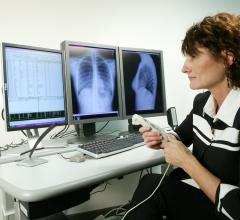With the variety of breast brachytherapy tools, what key factors should the patient and physician keep in mind?
YASHAR: Ease of use and flexibility are the key factors that led me to choose [Cianna Medical’s] SAVI applicator for the majority of my brachytherapy procedures.
Interstitial brachytherapy, which consists of 15-20 catheters individually inserted in the breast, enables physicians to tailor the dose based on a patient’s anatomy. However, it is a very technically difficult procedure and is therefore not widely available.
‘Balloon’ brachytherapy is far easier to employ, as it consists of one catheter attached to a balloon that is inserted through a single-entry point. However, the uniform distribution of radiation removes the physicians’ ability to customize the radiation delivery. Unfortunately, this eliminates many women as candidates for treatment, such as women with small breasts or those with minimal space between the balloon and their skin. In fact, as many as 40 percent of my brachytherapy patients are not candidates for the balloon because of such technical restrictions.
The single-entry, multi-catheter SAVI applicator is both flexible and easy to use. It is the only single-entry device that allows physicians to customize radiation based on the size and shape of the cavity. SAVI spares healthy tissue while directing radiation to where it is needed most. That can make brachytherapy available to women who would otherwise be ineligible for such treatment.
Which imaging modalities work well with SAVI and why? Which do you offer at your facility?
I use both ultrasound and CT with SAVI. CT is effective for pre-treatment planning. It allows me to evaluate the size, shape and volume of the cavity, which is helpful for deciding the most effective size of device to use. During insertion, I utilize ultrasound because it helps in guiding the device and makes placement much more accurate. Inserting SAVI without ultrasound would certainly be more difficult.
Accuracy, consistency, speed and patient comfort are key components for a breast brachytherapy procedure. How do the tools you use help you deliver quality care?
The multi-catheter design of SAVI makes it an extremely accurate form of treatment. It enables physicians to deliver radiation with precision to the cancerous site, avoiding critical structures like the skin, chest wall or lungs. This ability extends the benefits of a five-day radiation treatment to a larger group of women. Breast brachytherapy is a more convenient alternative to the six to seven weeks required for whole breast radiation therapy.
In addition, SAVI enhances patient comfort with its easy insertion and removal. It is inserted using local anesthetic and is nearly painless to remove. Pain hasn’t been a complaint from any of the patients I have treated with SAVI to date.
How do you handle individual patient challenges, or deviations from clinical pathways, with the tools you use?
An irregularly shaped cavity is one of the biggest challenges any physician faces in their desire to offer the benefits of breast brachytherapy. Very few cavities are perfectly spherical in nature, which is why many women are ineligible for treatment with the balloon. The SAVI device enables even women with cavities as small as 5-10 cc to still receive breast brachytherapy. Before SAVI, these women would have had far fewer options for breast brachytherapy and may have been forced to choose whole breast irradiation.
What's the biggest challenge you faced in evaluating and implementing SAVI, as opposed to other products or other procedures? What would you tell other women's healthcare centers contemplating a similar decision?
My adoption of SAVI was amazingly smooth. Preparation is the key to an effective implementation. Prior to my first SAVI procedure, I observed a physician insert the device and conducted a dry run of the placement process to ensure we had the necessary supplies. In addition, our physicist prepared himself by observing the treatment planning at another facility. Investing the time in these preparatory steps is crucial for eliminating potential challenges during your first procedure.
What are some of the noteworthy clinical, financial and operational benefits you've derived from implementing SAVI?
The ability of SAVI to sculpt the dose for each individual woman has allowed our facility to make breast brachytherapy available to more women. This has an obvious clinical benefit for women seeking to undergo brachytherapy, as well as a financial benefit to the facility.
Particularly if you are the only center in your service area offering this new technology, there is a greater chance of receiving referrals from surgeons not currently referring women to your facility. As more women learn about the benefits of SAVI and more surgeons increase their referrals, there is a definite possibility of an increase in the number of women you will treat. This is a positive development both for women’s health and your institution’s financial health.


 July 28, 2017
July 28, 2017 




